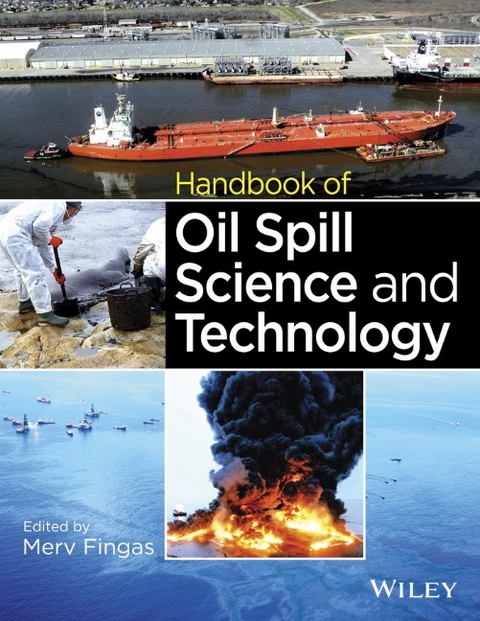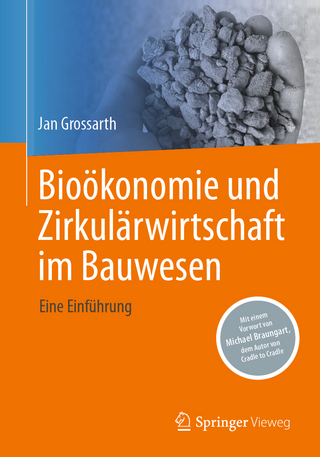
Handbook of Oil Spill Science and Technology
John Wiley & Sons Inc (Verlag)
978-0-470-45551-7 (ISBN)
Provides a scientific basis for the cleanup and for the assessment of oil spills
Enables Non-scientific officers to understand the science they use on a daily basis
Multi-disciplinary approach covering fields as diverse as biology, microbiology, chemistry, physics, oceanography and toxicology
Covers the science of oil spills from risk analysis to cleanup and through the effects on the environment
Includes case studies examining and analyzing spills, such as Tasman Spirit oil spill on the Karachi Coast, and provides lessons to prevent these in the future
Merv Fingas has 40 years of experience in oil and chemical spill research. He has authored over 850 technical publications and papers including books, manuals and over 500 peer-reviewed papers. He has won over 20 awards for research and papers from the United States Government, Canadian Government and international conferences. Dr. Fingas has also collaborated on studies with over 25 organizations around the world, coordinated studies for over 30 years through 6 internationally-attended committees and developed co-operative projects with many international groups.
Contributors xvii
Author Biographies xix
Preface xxvii
PART I Risk Analysis 1
1 Risk Analysis and Prevention 3
Dagmar Schmidt Etkin
1.1 Introduction 3
1.2 Executive Summary 3
1.3 Oil Spill Risk Analysis 4
1.4 Overview of Oil Spill Prevention 28
References 34
PART II Oil Properties 37
2 Oil Physical Properties: Measurement and Correlation 39
Bruce P. Hollebone
2.1 Introduction 39
2.2 Bulk Properties of Crude Oil and Fuel Products 39
2.3 Hydrocarbon Groups 44
2.4 Quality Assurance and Control 46
2.5 Effects of Evaporative Weathering on Oil Bulk Properties 46
References 49
PART III Oil Composition and Properties 51
3 Introduction to Oil Chemistry and Properties 53
Merv Fingas
3.1 Introduction 53
3.2 The Composition of Oil 53
3.3 Properties of Oil 75
References 76
4 Vegetable Oil Spills: Oil Properties and Behavior 79
Merv Fingas
4.1 Introduction 79
4.2 The Oils 79
4.3 Historical Spills 79
4.4 Aquatic Toxicity 86
4.5 Properties of the Oils 86
4.6 Behavior in the Environment 87
4.7 Oxidation Biodegradation and Polymerization 87
4.8 Spill Countermeasures 88
4.9 Biofuels 88
4.10 Conclusions 89
References 89
PART IV Oil Analysis 93
5 Chromatographic Fingerprinting Analysis of Crude Oils and Petroleum Products 95
Chun Yang, Zhendi Wang, Bruce P. Hollebone ,Carl E. Brown, Zeyu Yang, and Mike Landriault
5.1 Introduction 95
5.2 Introduction to Oil Analysis Techniques 100
5.3 Methodology of Oil Fingerprinting Analysis 105
5.4 Weathering Effect on Oil Chemical Composition 141
5.5 Diagnostic Ratios of Target Hydrocarbons 148
5.6 Forensic Oil Spill Identification: A Case Study 151
References 158
6 Oil Spill Identification 165
Joan Albaigés, Paul G.M. Kienhuis, and Gerhard Dahlmann
6.1 Introduction 165
6.2 Sampling 167
6.3 Sample Handling in the Laboratory 170
6.4 Analysis 171
6.5 Conclusions 198
References 202
PART V Oil Behavior 205
7 Oil and Petroleum Evaporation 207
Merv Fingas
7.1 Introduction 207
7.2 Review of Historical Concepts 209
7.3 Development of New Diffusion-Regulated Models 213
7.4 Complexities to the Diffusion-Regulated Model 218
7.5 Use of Evaporation Equations in Spill Models 220
7.6 Volatilization 221
7.7 Measurement of Evaporation 221
7.8 Summary 221
References 222
8 Water-in-Oil Emulsions: Formation and Prediction 225
Merv Fingas and Ben Fieldhouse
8.1 Introduction 225
8.2 Types of Emulsions 225
8.3 Stability Indices 226
8.4 Formation of Emulsions 230
8.5 Modeling the Formation of Water-in-Oil Emulsions 235
8.6 Conclusions 251
References 268
9 Oil Behavior in Ice-Infested Waters 271
Merv Fingas and Bruce P. Hollebone
9.1 Introduction 271
9.2 Spreading on Ice 271
9.3 Spreading on or in Snow 273
9.4 Spreading under Ice 273
9.5 Spreading on Water with Ice Present 274
9.6 The Effect of Gas on Oil-under-Ice Spreading 275
9.7 Movement through Ice 276
9.8 Oil in Leads 277
9.9 Absorption to Snow and Ice 280
9.10 Containment on Ice 280
9.11 Heating Effect of Oil on the Surface of Ice 280
9.12 Oil under Multiyear Ice 280
9.13 Oil in Pack Ice 281
9.14 Growth of Ice on Shorelines and Effect on Oil Retention 281
9.15 Effect of Oil on Ice Properties 281
9.16 Concluding Remarks 283
References 283
PART VI Modeling 285
10 Introduction to Spill Modeling 287
Merv Fingas
10.1 Introduction 287
10.2 An Overview of Weathering 287
10.3 Evaporation 288
10.4 Water Uptake and Emulsification 290
10.5 Natural Dispersion 293
10.6 Summary of Natural Dispersion 295
10.7 Other Processes 295
10.8 Movement of Oil and Oil Spill Modeling 297
10.9 Spill Modeling 299
References 299
11 Oceanographic and Meteorological Effects on Spilled Oil 301
C.J. Beegle-Krause and William J. Lehr
List of Symbols 301
11.1 Introduction 301
11.2 Chapter Scope 302
11.3 Atmospheric Boundary Layer 302
11.4 Water Currents 303
11.5 Waves 304
11.6 Sea Spray 306
11.7 Langmuir Cells 306
11.8 Oil Transport 307
11.9 Areas of Active Research 308
References 309
PART VII Detection Tracking and Remote Sensing 311
12 Oil Spill Remote Sensing 313
Merv Fingas and Carl E. Brown
12.1 Introduction 313
12.2 Atmospheric Properties 314
12.3 Oil Interaction with Light and Electronic Waves 314
12.4 Visible Indications of Oil 316
12.5 Optical Sensors 317
12.6 Laser Fluorosensors 325
12.7 Microwave Sensors 326
12.8 Slick Thickness Determination 331
12.9 Integrated Airborne Sensor Systems 333
12.10 Satellite Remote Sensing 334
12.11 Oil-Under-Ice Detection 340
12.12 Underwater Detection and Tracking 340
12.13 Small Remote-Controlled Aircraft 344
12.14 Real-Time Displays and Printers 345
12.15 Routine Surveillance 345
12.16 Future Trends 346
12.17 Recommendations 347
References 348
13 Detection Tracking and Remote Sensing: Satellites and Image Processing (Spaceborne Oil Spill Detection) 357
Konstantinos Topouzelis, Dario Tarchi, Michele Vespe, Monica Posada, Oliver Muellenhoff and Guido Ferraro
13.1 Introduction 357
13.2 Oil Spills Detection by Satellite 358
13.3 From Research to Operational Services 366
13.4 Ancillary Data 375
13.5 Summary and Conclusions 378
References 381
14 Detection of Oil in with and under Ice and Snow 385
Merv Fingas and Carl E. Brown
14.1 Introduction 385
14.2 Overview of Detection of Oil in or under Ice and Snow 385
14.3 Detection of Surface Oil with Ice: Conventional Techniques 392
14.4 Conclusions 392
References 392
PART VIII Oil Spills on Land 395
15 Bioremediation of Oil Spills on Land 397
Lisa D. Brown and Ania C. Ulrich
15.1 Introduction 397
15.2 Brief Overview of Bioremediation Techniques for Land Oil Spills 397
15.3 Key Organisms Involved in Biodegradation of Oil Spills on Land 398
15.4 Environmental Factors Affecting Bioremediation 399
15.5 In Situ Bioremediation Strategies 400
15.6 Ex Situ Land Treatment Techniques 402
15.7 Bioaugmentation Strategies 404
15.8 Biostimulation Strategies 404
References 405
16 Microbe-Assisted Phytoremediation of Petroleum Impacted Soil: A Scientifically Proven Green Technology 407
Karen E. Gerhardt, Perry D. Gerwing, Xiao-Dong Huang and Bruce M. Greenberg
16.1 Introduction 407
16.2 PGPR-Enhanced Phytoremediation System(s) 413
16.3 Case Studies of Full-Scale Petroleum Phytoremediation 416
16.4 Achieving Regulatory Criteria 421
16.5 Conclusions 422
References 423
PART IX Effects of Oil 429
17 Overview of Efforts to Document and Reduce Impacts of Oil Spills on Seabirds 431
Roger C. Helm, Harry R. Carter, R. Glenn Ford, D. Michael Fry, Rocío L. Moreno, Carolina Sanpera and Florina S. Tseng
17.1 Introduction 431
17.2 Vulnerability 433
17.3 Effect of Oiling on Individual Birds 435
17.4 Rehabilitation and Veterinary Care 436
17.5 Estimating Mortality 441
17.6 Long-Term Impacts 444
17.7 Restoration 446
References 448
18 Overview of Effects of Oil Spills on Marine Mammals 455
Roger C. Helm, Daniel P. Costa, Terry D. DeBruyn, Thomas J. O’Shea, Randall S. Wells and Terrie M. Williams
18.1 Introduction 455
18.2 Sea Otters 458
18.3 Seals and Sea Lions 461
18.4 Sea Cows 464
18.5 Polar Bears 465
18.6 Whales Dolphins and Porpoises 467
References 471
19 Oil Spill Impact and Recovery of Coastal Marsh Vegetation 477
Qianxin Lin
19.1 Introduction 477
19.2 Toxicity and Impact as a Function of Oil Type and Oil Weathering Degree 477
19.3 Sensitivity to Oil Varies by Plant Species 478
19.4 Effects of Oil Exposure Modes on Severity of Oil Impacts 479
19.5 Effects of Oil Spill Cleanup Procedures on Marsh Recovery 481
References 483
PART X Natural Dispersion 485
20 A Review of Natural Dispersion Models 487
Merv Fingas
20.1 Introduction 487
20.2 The Mackay Approach 487
20.3 The Audunson Approach 489
20.4 The Delvigne Approach 490
20.5 Residence in the Water Column 492
20.6 Comparison of the Models 492
20.7 Conclusions 494
References 494
PART XI Cold Region Spills 495
21 Arctic and Antarctic Spills 497
D.M. Filler, Mahlon C. Kennicutt II, I. Snape, Stephen T. Sweet and Andrew G. Klein
21.1 Introduction 497
21.2 Terrestrial Spills 502
21.3 Marine Spills 507
21.4 Policy 508
References 510
PART XII Case Studies 513
22 The Prestige Oil Spill 515
Joan Albaigés ,Ana Bernabeu, Sonia Castanedo, Núria Jiménez, Carmen Morales-Caselles, Araceli Puente and Lucía Viñas
22.1 Introduction 515
22.2 The Ocean and Coastal Dynamics in the NW Iberia and their Influence on the Spill 516
22.3 Oil Monitoring and Fate 521
22.4 The Assessment of Effects 531
22.5 Environmental Restoration 537
22.6 Conclusion 541
References 542
23 The Grounding of the Bahía Paraíso Arthur Harbor Antarctica: Distribution and Fate of Oil Spill Related Hydrocarbons 547
Stephen T. Sweet, Mahlon C. Kennicutt II and Andrew G. Klein
23.1 Introduction and Background 547
23.2 Environmental Sampling 550
23.3 Conclusions 555
References 555
24 Tasman Spirit Oil Spill at Karachi Coast Pakistan 557
Hina Ahsan Siddiqi and Alia Bano Munshi
24.1 Introduction 557
24.2 Immediate Response to the Impact: Actions and Remediation 55724.2.1 Oil Recovery and Coast Cleaning 558
24.3 The DDWP Project by Ministry of Science and Technology (MoST) 561
24.4 Hydrodynamics and Meteorological Data 562
24.5 Oil Monitoring and Fate 564
24.6 Effects of Oil Impact at the Community Level 568
24.7 Bioremediation/Natural Attenuation Processes 572
24.8 Conclusions 572
References 573
PART XIII Appendices 575
Appendix A The Oil Properties Data Appendix 577
Bruce P. Hollebone
Appendix B Conversions 683
Merv Fingas
Appendix C Ice Nomenclature 685
Merv Fingas
Index 689
| Erscheint lt. Verlag | 24.3.2015 |
|---|---|
| Verlagsort | New York |
| Sprache | englisch |
| Maße | 221 x 279 mm |
| Gewicht | 1905 g |
| Themenwelt | Naturwissenschaften ► Biologie ► Ökologie / Naturschutz |
| Naturwissenschaften ► Chemie | |
| Technik ► Umwelttechnik / Biotechnologie | |
| ISBN-10 | 0-470-45551-9 / 0470455519 |
| ISBN-13 | 978-0-470-45551-7 / 9780470455517 |
| Zustand | Neuware |
| Haben Sie eine Frage zum Produkt? |
aus dem Bereich


